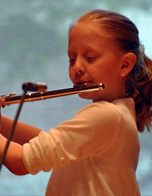Show 196: Listening Guide

Emma Resmini
This week’s show, recorded at the WGBH Fraser Performance Studio in Boston, begins From the Top’s 10th Anniversary celebration. In addition to featuring special alumni guest, William Harvey, the show also includes a 9-year-old flutist, a chamber ensemble from the New England Conservatory’s Youth Philharmonic Orchestra, a counter tenor and a clarinet trio. We asked each of these unique artists to tell us something interesting about the piece of music they are playing and why they like it. (Check local stations for air times. The episode will be available online later this week at www.fromthetop.org.)
Emma Resmini, 9, flute
Concertino by Cecile Chaminade
“I try to think of a story in my head and try to make the audience feel like they are soaring, flying, and dancing when I play my flute.”
William Harvey, special alumni guest, violin
Souvenir d’Amerique, Op. 17 by Henri Vieuxtemps
“The Yankee Doodle Variations always make people smile, especially if you call the piece by its correct title: Souvenir of America. That way people chuckle when they hear that recognizable theme for the first time. Performing this piece in Egypt helped introduce Egyptians to American culture in a whimsical way. The piece is funny, so it is important to make sure the timing is just right. Most pieces classical musicians play are too serious. Come on, let’s lighten up, people! I feel proud as an American to play this piece: since the composer was French, it underscores America’s oldest alliance.”
The Shapka Trio, Anthony Brackett – Ensemble Coach
IV. Allegro from Clarinet Trio in A minor, Op. 114 by Johannes Brahms
Dasha Bukhartseva, 16, piano (Shapka Trio)
“This trio is the first piece I’ve ever played by Brahms and I love it! Every time when we’re playing it, it seems to me that I am in a huge wood on the edge of the world in October and the rain drizzles very annoyingly. And the music gives the impression of anguish and grief. Brahms doesn’t end the first movement with ‘the big ending’ sound, like we were abandoned in this hopeless darkness. I think that Brahms wanted to give us this feeling, because he wrote it when he was a desperate old man.”
Madeline Fayette, 17, cello (Shapka Trio)
“There are a lot of singing moments between the cello and the clarinet that aren’t technical anymore. You could physically sing them. It’s meant to be sung… I guess the ending stinks because it’s over!”
Christopher Pell, 18, clarinet (Shapka Trio)
“The piece is special because it exposes the most beautiful parts of each instrument. The piece was written for Brahms’s friend, a clarinetist named Richard Muhlfeld, who had such a beautiful tone that Brahms came out of retirement in order to compose for him.”
Caleb Barnes, 17, countertenor
Dove sei, amato bene? by George Frederic Handel
“My voice teacher Shigemi Matsumoto, says everyone should have a ‘2 a.m.’ piece of music: in other words, a song you can sing at any time, easily. This is my ‘2 a.m.’ song, not only because I know it so well, but because it fits my voice so well…. This song is so sorrowful and full of yearning that it was difficult to get that emotion to the audience. I now picture a very lonely moment in my life and use that to show the heartbreak.”


